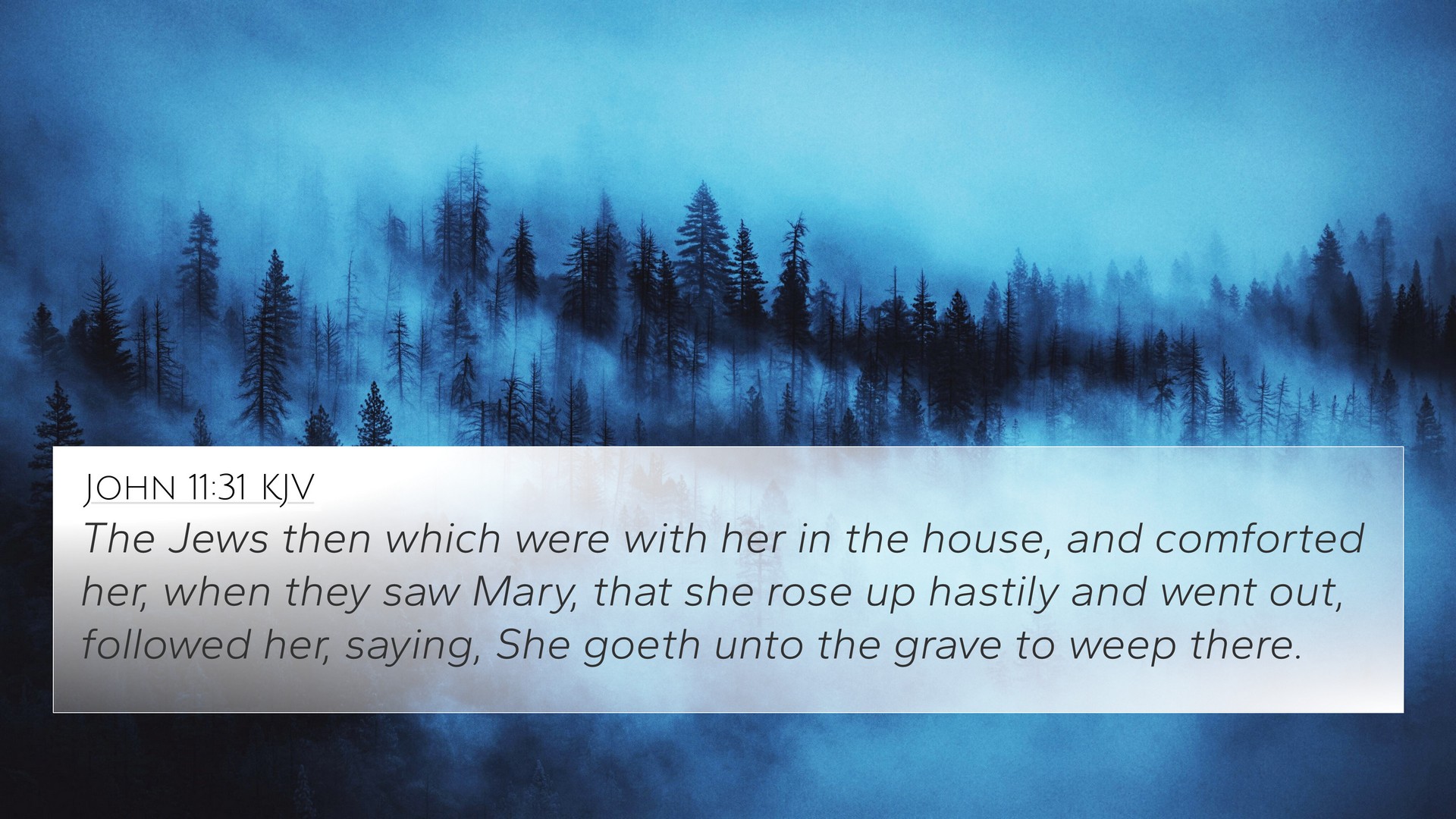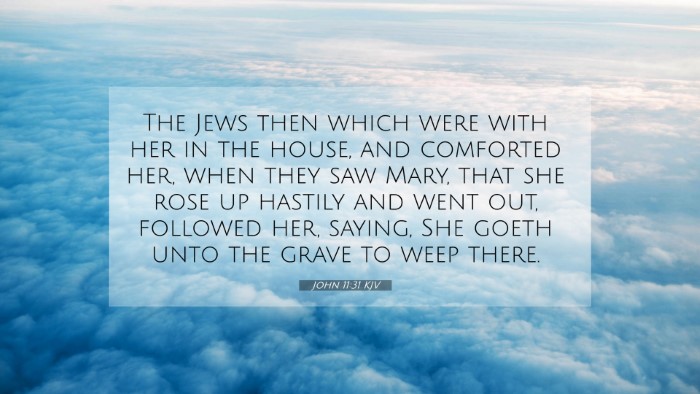Understanding John 11:31
John 11:31 relates to a moment of deep sorrow and emotional weight within the Gospel narrative. As Jesus arrives at the tomb of Lazarus, His close friend who had died, the depth of the grieving scene is vividly portrayed. In this context, we explore the implications of this verse and its connections to broader scriptural themes and parallels.
Verse Context
In the preceding verses of John 11, we see the illness of Lazarus and the delayed response of Jesus (John 11:1-16). Upon His arrival, Jesus is met by Martha and Mary, Lazarus' sisters, both expressing their grief and disappointment. This particular verse captures the reaction of the mourners when they see Jesus, as it highlights the communal sorrow in the face of death.
Interpretation Insights
-
Matthew Henry:
Henry emphasizes the human emotion present in this scene. He reflects on how the presence of Jesus evokes sorrow among the mourners and illustrates the empathy and compassion of Christ in the face of human suffering. It serves to show not only the impact of death but also Christ's willingness to engage with our pain.
-
Albert Barnes:
Barnes notes the social aspect of mourning in this passage. The weeping of the Jews signifies the depth of their connections, further intensifying the emotional atmosphere surrounding Lazarus’s death. He aligns it with Christ's identity as a comforter and a source of hope even in despair.
-
Adam Clarke:
Clarke reflects on the cultural customs surrounding death during Biblical times, explaining how the collective mourning practices further illustrate the seriousness of the situation. He also discusses the implications of Jesus’ presence, recognizing that it signals a transformation from sorrow to potential hope and resurrection.
Bible Cross-References
To enhance the understanding of John 11:31, we can examine several cross-references that relate to themes of grief, resurrection, and comfort.
- John 11:35 - "Jesus wept." - Demonstrates Jesus's profound empathy and emotional connection with human suffering.
- Romans 12:15 - "Rejoice with those who rejoice; mourn with those who mourn." - Emphasizes communal grief and support.
- 1 Thessalonians 4:13 - "We do not grieve like the rest of mankind, who have no hope." - Contrasts the sorrow of believers with that of those without faith.
- Ecclesiastes 3:1-4 - "A time to weep, and a time to laugh..." - Reflects the cyclical nature of life and emotions.
- Revelation 21:4 - "He will wipe every tear from their eyes..." - Offers hope beyond current sorrows.
- Psalm 34:18 - "The Lord is close to the brokenhearted..." - Affirms God's presence in our grief.
- Isaiah 53:3 - "A man of sorrows, and acquainted with grief..." - Portrays Jesus as familiar with human suffering.
Thematic Connections Between Bible Verses
This verse illustrates important connections across the scriptures, particularly regarding Jesus' role as a sympathizing figure amidst tragedy. By tracing links between Old and New Testament scriptures, we can see how grief and hope are intertwined throughout the narrative.
-
Connecting with the Old Testament:
The struggles depicted in the Psalms resonate with the emotions seen in John 11. The anguish expressed in Psalm 42:3 ("My tears have been my food day and night") speaks to the intense sorrow felt in moments like Lazarus’ death.
-
Dialogue Between the Gospels:
The empathetic nature of Christ is a strong theme in all four Gospels, with similar accounts of His interactions with grief and suffering, as seen in Mark 5:35-43 in reference to Jairus’s daughter.
Conclusion
John 11:31 provides a profound example of the emotional connections present within the context of loss and mourning. The insights gleaned from public domain commentaries underscore the significance of Jesus’ empathy. This verse invites readers to explore deeper emotional themes within scripture, promoting comfort and the assurance of hope through Christ even amidst sorrow. The cross-references enhance our understanding of the collective nature of grief and the powerful role of Jesus as the one who meets us in our pain.
Exploring Further
If you are interested in a comprehensive exploration of cross-referencing Biblical texts, there are many Bible reference resources available, such as Bible concordance and cross-reference guides. These tools can assist in drawing links between verses that discuss similar themes or narratives, enriching your study and understanding of the inter-Biblical dialogue.






